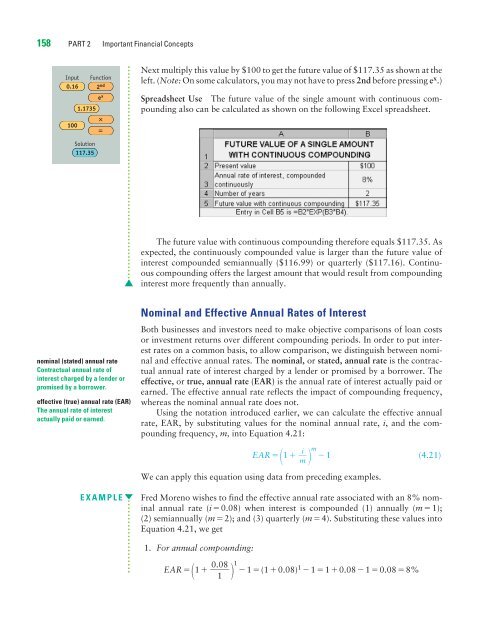Read the Chapter 4 E-Book
Read the Chapter 4 E-Book
Read the Chapter 4 E-Book
Create successful ePaper yourself
Turn your PDF publications into a flip-book with our unique Google optimized e-Paper software.
158 PART 2 Important Financial Concepts<br />
0.16 2nd Input Function<br />
100<br />
1.1735<br />
Solution<br />
117.35<br />
e x<br />
<br />
<br />
nominal (stated) annual rate<br />
Contractual annual rate of<br />
interest charged by a lender or<br />
promised by a borrower.<br />
effective (true) annual rate (EAR)<br />
The annual rate of interest<br />
actually paid or earned.<br />
Next multiply this value by $100 to get <strong>the</strong> future value of $117.35 as shown at <strong>the</strong><br />
left. (Note: On some calculators, you may not have to press 2nd before pressing e x .)<br />
Spreadsheet Use The future value of <strong>the</strong> single amount with continuous compounding<br />
also can be calculated as shown on <strong>the</strong> following Excel spreadsheet.<br />
The future value with continuous compounding <strong>the</strong>refore equals $117.35. As<br />
expected, <strong>the</strong> continuously compounded value is larger than <strong>the</strong> future value of<br />
interest compounded semiannually ($116.99) or quarterly ($117.16). Continuous<br />
compounding offers <strong>the</strong> largest amount that would result from compounding<br />
interest more frequently than annually.<br />
Nominal and Effective Annual Rates of Interest<br />
Both businesses and investors need to make objective comparisons of loan costs<br />
or investment returns over different compounding periods. In order to put interest<br />
rates on a common basis, to allow comparison, we distinguish between nominal<br />
and effective annual rates. The nominal, or stated, annual rate is <strong>the</strong> contractual<br />
annual rate of interest charged by a lender or promised by a borrower. The<br />
effective, or true, annual rate (EAR) is <strong>the</strong> annual rate of interest actually paid or<br />
earned. The effective annual rate reflects <strong>the</strong> impact of compounding frequency,<br />
whereas <strong>the</strong> nominal annual rate does not.<br />
Using <strong>the</strong> notation introduced earlier, we can calculate <strong>the</strong> effective annual<br />
rate, EAR, by substituting values for <strong>the</strong> nominal annual rate, i, and <strong>the</strong> compounding<br />
frequency, m, into Equation 4.21:<br />
EAR 1 m i<br />
1 (4.21)<br />
We can apply this equation using data from preceding examples.<br />
EXAMPLE Fred Moreno wishes to find <strong>the</strong> effective annual rate associated with an 8% nominal<br />
annual rate (i0.08) when interest is compounded (1) annually (m1);<br />
(2) semiannually (m2); and (3) quarterly (m4). Substituting <strong>the</strong>se values into<br />
Equation 4.21, we get<br />
1. For annual compounding:<br />
0.08<br />
<br />
1<br />
EAR 1 1<br />
m<br />
1(1 0.08) 1 110.08 10.08 8%

















